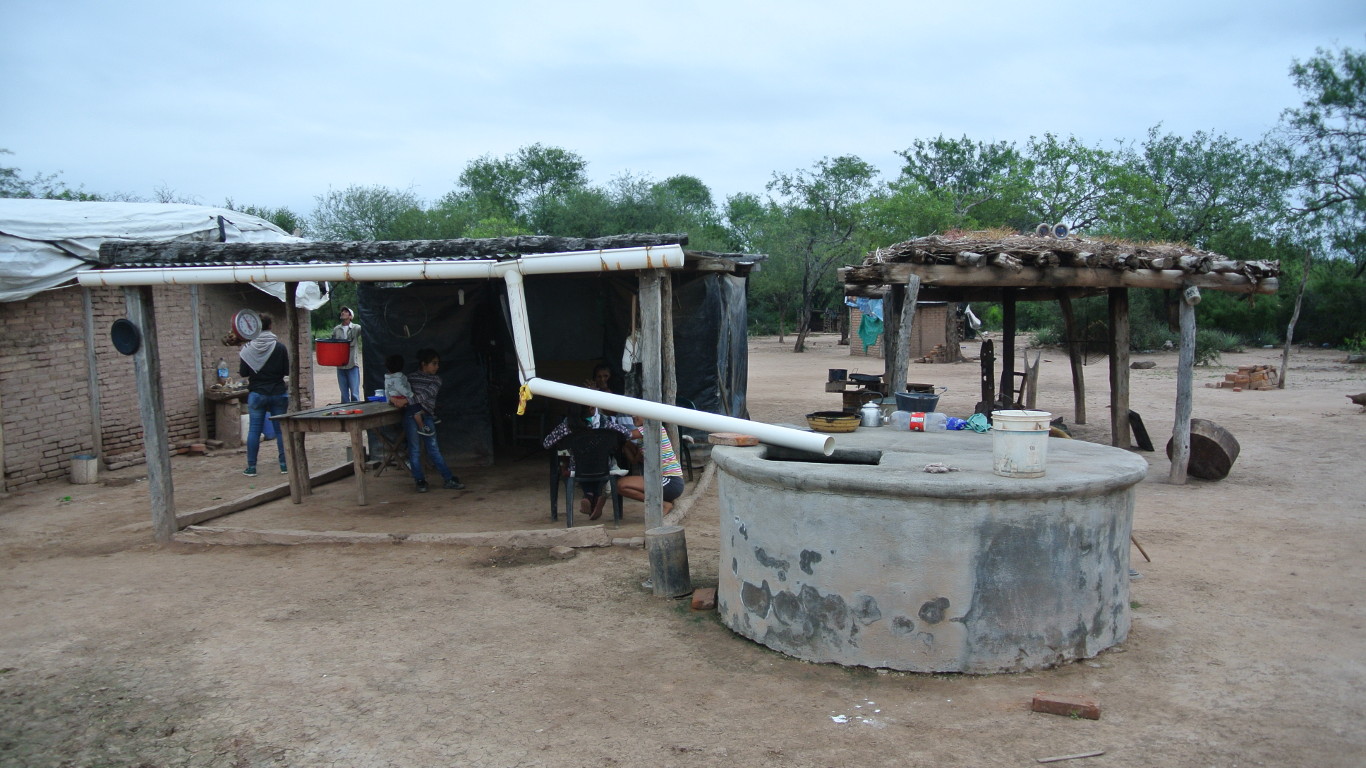Idea
In the course of the master’s program, our group of civil engineering students wished to use our acquired knowledge in the form of a project in the field of development aid. In the search for a suitable project, we asked various national subsidiaries of “Engineers without Borders” about possible projects. Finally, a project was selected in collaboration with “Ingeniería Sin Fronteras Argentina” (ISF-A).
The project involved the design and construction of two small reinforced concrete bridges in northern Argentina. With this concrete idea, further students, including a student of the course “Spatial Development and Infrastructure Systems”, as well as a medical student could be won for the project. The project was started in October 2012 with a total of 14 motivated participants.

Project description
The rural population around Colonia Dora, located in the province of Santiago del Estero in northern Argentina, is increasingly isolated due to the inadequate condition of the transport infrastructure. The numerous creeks and irrigation channels contribute to this. A drinking water supply of the population from local groundwater is not possible due to the natural arsenic contamination of the groundwater. The drinking water supply is therefore provided by trucks, which currently have no access to the Puente Negro, Mancapa and Tacón regions. This is due to the extremely poor condition of the existing bridges, which are impossible to cross for the ten-ton trucks.
Also, the social and economic development of the region is significantly affected by these circumstances. The arid climate in combination with the nutrient-poor soil, allows the local farmers only the cultivation of the clover Alfalfa, which is sold for cattle feeding. However, since large transport vehicles can not cross the bridges, Alfalfa trade is also limited for farmers in the isolated area. Alfalfa can therefore not be profitably grown.
In order to improve this situation, various adjustments of the existing infrastructure, in particular the replacement of the existing bridges and the improvement of the access roads, are necessary. Due to lack of commitment on the part of local and state authorities, ISF-A decided to take the initiative with us.

Project planning phase
The design of the larger of the two bridges took place in different groups parallel to the study in the spring semester 2013. This included the preparation of the static calculations, the reinforcement and the shuttering plans.
It is a reinforced concrete slab bridge with a length of about 10m divided into three spans. In the upper and underwater area of the bridge erosion protection structures are provided due to the narrowing of the channel cross section. The protection consists of vertical wing walls clamped in a bottom plate. To prevent the formation of colc below the bottom plate, two parallel to the bridge axis extending concrete teeth are arranged in the upper and lower water area.
In order to cover the material costs of the big bridge, we started a fundraising campaign parallel to the project planning tasks. For this purpose, various companies and foundations throughout Switzerland were asked for assistance. The fundraising campaign was successfully completed a few weeks before we left. The funds collected were then transferred to ISF-A so that the needed building materials and tools could be purchased well in advance of our arrival in Colonia Dora.


Arrival and project execution
At the beginning of July 2013 we were finally able to start. After most of the students had completed their master’s thesis, we left for the master’s trip to Rio de Janeiro together with the rest of the study program. Following the 12 days in the city at the Atlantic Ocean, our group set off by plane for Puerto Iguazú on the border between Brazil and Argentina.
After visiting the Iguazú National Park with its famous waterfalls and the Itaipú Dam we took the trip by rental car in the direction of Colonia Dora. It was followed by stops with one overnight stay in the cities of Posadas and Corrientes. After three days driving through the Argentine pampas, we reached Colonia Dora on the evening of July 21st. There we enjoyed a very warm welcome by a team of ISF-A.
For the next three weeks we were accommodated in the local secondary school “EFA Avellaneda”. Secondary school students take turns spending two weeks each at school, and then spend two weeks at home. Thus, the sometimes very extensive school trails are less significant and the children can still help at home on the farms despite the school education.
In the first week we had the bedrooms due to school holidays to us alone. For our physical well-being the school cook Norma took care and the janitor Juan cared lovingly for all other kinds of concerns. We felt very comfortable and welcome in our new home.

Construction works
On Monday, July 22, the first working day was scheduled. After our first night at school, we woke up in icy temperatures below freezing point. On the daily program were primarily the site review and moving the equipment to the construction site.

When we arrived at the construction site, however, we experienced a first disillusionment. Although the excavation and diversion of the canal were completed as planned, we did not have nearly the tools and machines we had negotiated in advance. We did not let ourselves be deterred. After all, a certain difference to a swiss construction site had to be expected. We had already calculated and designed the bridge in the months before departure in Switzerland. Shortly before the departure to Rio de Janeiro, however, changes were made by the argentinian project team. Certain parts of the building had to be redesigned on site. These were the flow guiding components before and after the actual bridge.
Furthermore, the excavation pit had to be measured, the geometry of the bridge staked out and the workshop set up on the construction site. So different teams were formed, and we got to work.
Most of the surveying was carried out with the simplest means, although for some works even a tachymeter was available at times. It soon became clear that there were major differences from the measuring accuracy impressed on us at ETH Zurich. The dimensions of the excavation were only approximate, and so we spent the first day laboriously tinkering with the earthworks.

After completion of the excavation work, it was time to create the lean concrete slab. This serves to obtain a clean plan as a basis for further construction. This work was clearly underestimated on our part and brought us close to despair for the first time. After we had made the additions, water and cement to the site, ten people were needed to mix with the much too small, generator-driven concrete mixer, which only holds a volume of 60 liters, to mix and pour the concrete.
Our improvisation skills were put to the test for the first time, and luckily we were able to organize a larger, 180 liter concrete mixer the next day. With this the lean concrete slab could be finished almost in record speed.
The reinforcement layout including the associated iron list, which was still created in Switzerland, turned out to be of limited usefulness. The irons were not delivered as expected in the specified lengths and shapes instead there were only 12m long bars of two diameters available. This resulted in a new and unexpected task: To minimize the cutting waste, the pattern had to be optimized first. After cutting, the iron had to be bent to the required shape, which was done on an improvised bending table and using the simplest of tools.

Parallel to the production of the lean concrete slab, team reinforcement produced the two reinforcing baskets for the colc protection off the construction site. This involved cutting the irons, bending the closed temples, producing the wires for tying the reinforcement and actually tying the baskets. One day was needed for laying out the reinforcement and pouring concrete.

Already from our first arrival on the construction site we were a big attraction for the inhabitants of Colonia Dora. Mayor Juan and his ward clerk Ramon welcomed us officially on the site and promised to do everything in their power to help us. We would definitely get back to her on that.
The remaining inhabitants were a bit more skeptical. In the first days we were mainly observed while working. Only few dared to help. However, this changed during our stay.
Life off the construction site
In addition to our construction activities, the social life was not be neglected and both for ISF-A, as well as for the village population, it was important that we get an insight into life in Colonia Dora and Santiago del Estero. One day a class of the technical university visited us in Santiago del Estero. Some of them did a great deal of pouring concrete and others helped us – or at least tried – to bring local music and dance performances into our lunch break. Another day, a soccer game was organized between us and a local team. After some back and forth, it finally came to a final score of 4: 3 for the Swiss team. The defeat burned a bit in the Argentine soccer soul, though that could be remedied during an Asado (argentinian style BBQ).


Also on the construction site progress continued steadily (albeit slower than planned). After the scour protection was made both upstream and downstream, the reinforcement of the base plate and the wing walls could be started. The entire floor slab was to be reinforced and concreted in three parts. First the downstream third of the bottom plate and the associated wing walls were reinforced. For this, the iron bars of different sizes and shapes had to be connected. Despite the commitment of the entire team, including two locals, we needed two full days. On the second day work continued even after dark. The light source was the headlights of our pick-up truck and mobile phone flashlights.
The following day we set off to the construction site very early to be able to concrete the now reinforced part of the floor slab. Due to the promised help of some locals, we were not only 14 workers, but a whole 25. It was now concreted in record time and shortly before dusk the first third of the floor slab was actually finished.

Until the completion of this component, we worked already nearly two weeks and thus took much longer than originally planned. Two days later, the departure of eight people from our group was imminent. The other six students decided to stay longer in order to drive the construction of the bridge forward

For the time-consuming concreting of the second section of the floor slab, the mayor was able to arrange a truck mixer, which would greatly reduce the time required. Also, the reinforcement went thanks to the experience gained and the help of the locals much faster than before. After only two days we were ready to pour concrete into this section.
Truck capacity dictated driving three loads of concrete to the construction site. The first delivery was brought in easily. Though we had to bring in the second delivery with wheelbarrows because of the too short reach of the excavator. Shortly after this was successfully brought in, we received the news that the truck mixer’s engine had suffered a defect. This happened not even a kilometer from the construction site and the driver had to empty the last delivery on the spot in the street. At the construction site, we had neither water, enough aggregate and cement, nor a functioning concrete mixer.
Before this situation, the almost desperate and perplexed Swiss got to know a previously unknown character trait of the Argentines. After 10 minutes of intense and loud complaining about the situation, their mood returned and changed into a zest for action. We split up, each one was ordered to another focal point. One of them went with a group of Argentines to the concrete on the street to bring it to the construction site with a truck, one stayed on the site and as much as possible set up everything to start concreting and organized the required materials and the third went to get a generator and a 180 liter mixer.
Thanks to brave engagement, we were all reunited at the concreting site two hours later. But the day was too short. Floodlights had to be set up so that we could finish concreting. At 9 pm, we were finally finishing the second part of the floor slab.
The following day, the last of our group, Colonia Dora, had to turn their backs with a heavy heart and head home.
What happened since then?
ISF-A has continued the construction work with the help of the local population since our departure, and at the end of December 2013 the deck was ready to be concreted. After various load tests and the removal of the by-pass channel , the bridge was officially inaugurated on March 29, 2014. Construction of the second bridge is scheduled for June 2014.

Note of thanks
We would like to sincerely thank the following sponsors, also on behalf of ISF-A, without whose help the locals in Puente Negro would wait a long time for the long-awaited bridge:
- Johannes Wild Fonds
- Erich Degen Stiftung
- Volkart Stiftung
- VSL Schweiz
- Akademischer Ingenieurverein AIV
- Debrunner Acifer
Finally, we look back on an eventful and instructive time in Colonia Dora, which we would not want to miss. Not only have we learned how to improvise and get along on a construction site with the simplest means, but also the ability to communicate with hands and feet, and in some cases even our Spanish language skills, have improved a lot. Last but not least after six years, we have come to learn still new sides of each other and are happy about this shared experience.

At this point we would like to sincerely thank Adán Levy and Joaquín Fernández of ISF-A for the great collaboration and to thank the people of Colonia Dora for the warm welcome.
Project participants
+ Arno Barandun, civil engineer, ETHZ
+ Anne‐Kathrin Bodenbender, engineer for regional developmentund infrastructure, ETHZ
+ Dominik Burkhart, civil engineer, ETHZ
+ Eric Carrera Escartín, civil engineer, ETHZ
+ Christian Greber, civil engineer, ETHZ
+ Daniele Giuliani, medical student, UZH
+ David Häring, civil engineer, ETHZ
+ Benjamin Jenne, civil engineer, ETHZ
+ Tai Ly, civil engineer, ETHZ
+ Orlando Molinari, civil engineer, ETHZ
+ Christian Nagy, civil engineer, ETHZ
+ Bandar Secchi, civil engineer, ETHZ
+ Christian Vögeli, civil engineer, ETHZ
+ Reto Weishaupt, civil engineer, ETHZ




